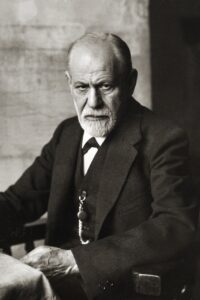When it comes to the human personality/psyche, it’s always beyond the wireframe of one’s brain. There’s a lot that shapes your personal self. Physical attributes, social circumstances, and mental health have the primary take. Over the year, you also learn, relearn and unlearn your memories and surroundings, which shape your personality and personal self. Several theorists and psychoanalysts have elaborated on such matters in their own way for centuries. However, they had always ventured a part or two. The theories by Sigmund Freud offered a comprehensive understanding of the personal self.
From the time you are born, your first analysis of something important to your changing attitude over the years. Freud has discussed it all!
What Is Psyche And How Is It Related To Personal Self?
How do you usually respond to the question, “What’s in your mind?” Most of the time, you reveal your thoughts when the person is someone close. Or, for a distant relative, you just try to drop off the question with a simple “nothing” as an answer.” Getting deeper into “What’s in your mind?” doesn’t mean the brain but thoughts rumbling in your head. It’s the conscious decisions you make, the dream you remember from the last night, how you decide to narrate your problems, and how you sometimes tend to doge off painful memories. Termed as “psyche” by theorists, it is how the human mind coordinates and gradually evolves to be a reputable self.

Originally coined by Plato, he believed the “psyche” or one’s “soul” is eternal and separate from the physical body. And there are still debates on trying to establish the truth behind it. Later on, Aristotle, Plato’s student, continued with the search. But he went on to add souls in animals and vegetables. And believed that rational souls kept humans segregated from others.
Top Theories By Sigmund Freud That Reveal One’s Personal Self
Sigmund Freud is better known for his contribution to the theories of psychoanalysis – comprising human fixations, unconsciousness, dream analysis, ego, and defense mechanisms. For those with a background in Psychology, the famous theories by Freud shape their ideologies about the mind and one’s personal self.

Moving on to a deeper understanding, here is a comprehensive list of some of the top theories by Sigmund Freud.
Theory Of Id, Ego, and Superego
Freud believed the human mind is divided into the conscious and the unconscious. One’s consciousness deals with everything they are aware of, and unconsciousness combines those that one is not aware of. You have desires, wishes, urges, hopes, and memories filled in the unconscious part, which, even in a not-so-obvious state, makes a point to influence the general behavior.

He further divided the human mind into three components, the id, ego, and super-ego.
- The Id: It is the source of all the libidinal energy and is entirely unconscious. Also, the Id is a primitive part of one’s personality serving as the source of all urges.
- The Ego: Your ego keeps you in check and helps satisfy the Id in safe, realistic, and socially acceptable ways.
- The Superego: The superego comprises all the morals and internalized standards one collects from parents and society.
It is the conjugation of the three in a balanced way, causing the human self to perform at its best. Your definition of “personal self” is shaped by the Id, Ego, and Superego.
Personality
Out of the multiple theories by Sigmund Freud, this one, in particular, draws attention to the different factors that affect one’s personality. The theory goes into elaborating cathexis and anticathexis alongside various instincts related to life and death. According to Freud, the libido generates one’s mental state. And the mental state, in the long run, is under the influence of two competing forces, cathexis and anticathexis.

- Cathexis. It is all about investing one’s psychic energy in an idea, person, fantasy, or project. Objects are believed to be “cathected” when an individual has emotional significance attached to the same.
- Anticathexis: It is where the ego monitors the socially unacceptable needs of an id. The Ego acts by diversifying emotions triggered by the Id to enter your consciousness.
Here is the catch of how socially evolved your “personal self” is and how you can balance it out without making things awkward. For example, if you are hungry, you can start placing orders randomly, driven by your Id. Or you can let your ego take things into hand and start behaving in a more socially acceptable way and order food as per your appetite.
The Eros And Thanatos Theory By Freud
It is the birth of a loved one or the death of someone which can directly or indirectly shape a person’s personality. And among the different theories by Sigmund Freud that offered a comprehensive understanding of the personal self, the Eros and Thanatos theory will help you understand “How human behavior is driven by life and death instincts?”

- Eros (Life instincts): Your needs are surrounded by basic pleasure, reproduction, and survival instincts. The energy created by life drive/life instincts is libido. The drive makes people participate in actions that will help them sustain their lives and surroundings. For example – taking care of one’s health and personal safety. Behaviors associated with life instincts include cooperation and love, helping people with ideas of harmonious co-existing.
- Thanatos (Death Instincts): In his essay “Beyond the Pleasure Principle,” Freud introduced the concept of Thanatos. His theory was based on clinical observations. Where the soldiers returning from World War 1 frequently revisited their traumatic experiences in the dream. According to Freud, people are driven by an unconscious desire to die. So a person with aggressive behavior after a traumatic experience in life is certainly them manifesting their death drive outward as anger towards others. And those incapable of draining it all out indulge in activities of suicide or self-harm.
As discussed, the human self goes through a lot of change, unlearning, learning, and relearning over time. And Freud, with his theories, has properly categorized those journeys, naming them under different theories.



